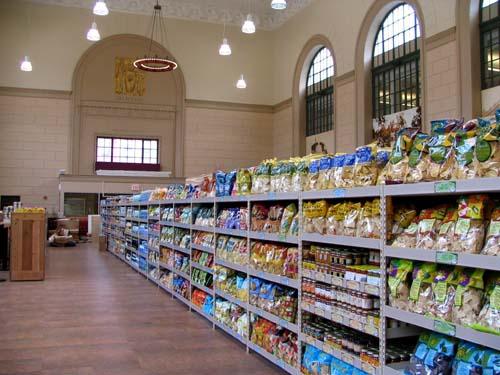The light streaming in from 40-foot-high windows illuminated the shelves of foodstuffs — bags of frozen organic strawberries, bottles of glistening extra virgin olive oil, boxes of Joe Joes and Joe’s O’s — marching down the aisles of Brooklyn’s new Trader Joe’s.
Four days before the store’s long-awaited grand opening, excitement was building within the dramatic space, the interior of the landmarked bank building at the corner of Atlantic Avenue and Court Street that has been recreated as a foodie paradise.
Carpenters finished work on fixtures such as the store’s tasting bar — aptly named What’s Cookin’ — where samples of foods sold by Trader Joe’s can be nibbled by customers. At the same time, Hawaiian shirt clad staffers scurried around, stacking shelves and freezers high with goodies that gourmet Brooklynites will soon be lining up to purchase.
Only the fresh food cases were empty. They will be filled at the last minute with fresh produce and meats, flowers and artisanal breads, explained Greg Glei, the store’s captain (or manager, for those who aren’t familiar with Trader Joe speak).
“We’re full of great products in every aisle,” Glei enthused as he showed this reporter around the store, the company’s first one in the borough. “Over 80 percent of the merchandise is private label,” Glei added. “We buy it direct from the manufacturer so we are able to pass along the savings to customers.”
The range of merchandise runs from raw ingredients to ready-to-heat entrees, meaning that both serious cooks and those who don’t have time for culinary pursuits will find something to suit their palates. “We’re full of great dinner options for people,” Glei remarked. “There’s also an incredible selection of things like cheese, coffee and chocolates from all over the world.”
Equally incredible, said Vanessa Chirgwin, the store’s first mate (AKA, assistant manager), is the setting. Rather than obliterating the 1923 structure’s original details, the Trader Joe’s team had burnished them, she pointed out.
“We really worked to preserve the space,” she noted. “We restored as much of it as we could to keep the original look and feel. Restoration was done to the wainscoting and the marble. We redid the ceiling. We refinished the lamps. It’s all the original windows. We are so lucky to have such a beautiful space, with such a nice, airy feel.”
To add to the atmosphere, Trader Joe’s store artists — who hand-lettered the signs on shelves — recreated old photos of Brooklyn landmarks as paintings. Thus, on one wall, are huge visuals of Coney Island’s “Loop-the-Loop,” the Brooklyn Bridge, Ebbets Field and Prospect Park, while, on the facing wall, a painting of horse-drawn fire engines in front of Borough Hall draws the eye.
At 14,000 square feet, the store is neither the smallest nor the largest of the chain’s over 300 stores around the country. Most Trader Joe’s, said Glei, are between 10,000 and 15,000 square feet in size.
All of this, however, is still a closed book to the future shoppers strolling by outside. A raw wooden panel covers the store’s main door, while a small sign reminds passersby that the grand opening will take place on September 26th.
Those who have passed by the emporium are eager for the doors to swing open, Glei reported. “Everyday, outside, we have folks walking by. If they see us in our Hawaiian shirts and nametags, they ask us when we’re opening. I feel there’s a lot of excitement in the neighborhood.”
The Monrovia, California-based grocery chain began in Southern California in 1958 as Pronto Markets. It was renamed Trader Joe’s in 1967. Product lines range from reinterpretations of classic grocery items to organic foodstuffs to vegetarian to gourmet. While certain products are perennial favorites, Trader Joe’s line is constantly expanding. The chain introduces approximately one dozen new items each week.






















